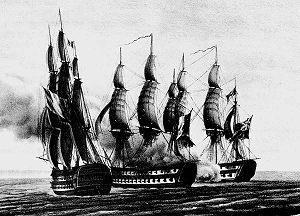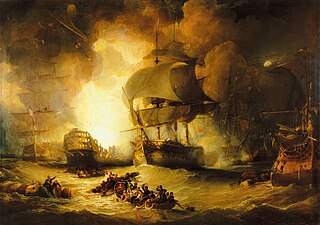
The Battle of the Nile was a major naval battle fought between the British Royal Navy and the Navy of the French Republic at Aboukir Bay on the Mediterranean coast off the Nile Delta of Egypt from the 1st to the 3rd of August 1798. The battle was the climax of a naval campaign that had raged across the Mediterranean during the previous three months, as a large French convoy sailed from Toulon to Alexandria carrying an expeditionary force under General Napoleon Bonaparte. The British fleet was led in the battle by Rear-Admiral Sir Horatio Nelson; they decisively defeated the French under Vice-Admiral François-Paul Brueys d'Aigalliers.

HMS Bellerophon, known to sailors as the "Billy Ruffian", was a ship of the line of the Royal Navy. A third-rate of 74 guns, she was launched in 1786. Bellerophon served during the French Revolutionary and Napoleonic Wars, mostly on blockades or convoy escort duties. She fought in three fleet actions: the Glorious First of June (1794), the Battle of the Nile (1798) and the Battle of Trafalgar (1805). While the ship was on blockade duty in 1815, Napoleon boarded Bellerophon so he could surrender to the ship's captain, ending 22 years of almost continuous war between Britain and France.

HMS Agamemnon was a 64-gun third-rate ship of the line of the British Royal Navy. She saw service in the American Revolutionary War, French Revolutionary and Napoleonic Wars, and fought in many of the major naval battles of those conflicts. She is remembered as being Nelson's favourite ship, and was named after the mythical ancient Greek king Agamemnon, being the first ship of the Royal Navy to bear the name.

HMS Ajax was an Ajax-class 74-gun third-rate ship of the line of the British Royal Navy. She was built by John Randall & Co of Rotherhithe and launched on the Thames on 3 March 1798. Ajax participated in the Egyptian operation of 1801, the Battle of Cape Finisterre in 1805 and the Battle of Trafalgar, before she was lost to a disastrous fire in 1807 during the Dardanelles Operation.

HMS Neptune was a 98-gun second-rate ship of the line of the Royal Navy. She served on a number of stations during the French Revolutionary and Napoleonic Wars and was present at the Battle of Trafalgar in 1805.

HMS Polyphemus, a 64-gun third-rate ship of the line of the Royal Navy, launched on 27 April 1782 at Sheerness. She participated in the 1801 Battle of Copenhagen, the Battle of Trafalgar, and the Siege of Santo Domingo. In 1813 she became a powder hulk and was broken up in 1827.

HMS Minotaur was a 74-gun third-rate ship of the line of the Royal Navy launched on 6 November 1793 at Woolwich. She was named after the mythological bull-headed monster of Crete. She fought in three major battles – Nile, Trafalgar, and Copenhagen (1807) – before she was wrecked, with heavy loss of life, in December 1810.

Charles-Alexandre Léon Durand, Comte de Linois was a French admiral who served in the French Navy during the reign of Napoleon Bonaparte. He commanded the combined Franco-Spanish fleet during the Algeciras Campaign in 1801, winning the First Battle of Algeciras before losing the Second Battle of Algeciras. He then led an unsuccessful campaign against British trade in the Indian Ocean and South China Sea in 1803, being defeated by a harmless fleet of the East India Company during the Battle of Pulo Aura and ending his cruise and sea-going career being bested in battle by John Warren in the action of 13 March 1806. Following the Bourbon restoration, Linois was appointed Governor of Guadeloupe. He supported Napoleon during the Hundred Days and so, on his return to France, he was forced to resign and was court martialled. Although acquitted, he was placed in retirement and never served again.

Orient was an Océan-class 118-gun ship of the line of the French Navy, famous for her role as flagship of the French fleet at the Battle of the Nile in August 1798, and for her spectacular destruction that day when her magazine exploded. The event was commemorated by numerous poems and paintings.

HMS Foudroyant was an 80-gun third rate of the Royal Navy, one of only two British-built 80-gun ships of the period. Foudroyant was built in the dockyard at Plymouth Dock and launched on 31 March 1798. Foudroyant served Nelson as his flagship from 6 June 1799 until the end of June 1800.

Tigre was a 74-gun ship of the line of the French Navy. Later it was captured by the British and, as HMS Tigre, operated as part of the Royal Navy throughout the Napoleonic Wars.
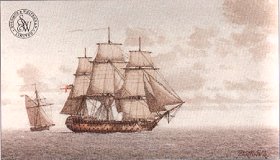
HMS Edgar was a 74-gun third-rate ship of the line of the Royal Navy, that saw service in the American Revolutionary, French Revolutionary and Napoleonic Wars. Launched in 1779, she fought in the battles of Cape St Vincent and Copenhagen, two of the major naval engagements of the wars.
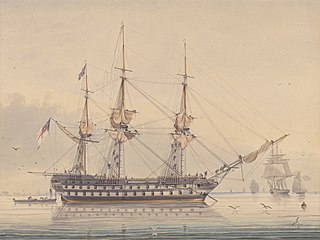
HMS Donegal was launched in 1794 as Barra, a Téméraire class 74-gun ship of the line of the French Navy. She was renamed Pégase in October 1795, and Hoche in December 1797. The British Royal Navy captured her at the Battle of Tory Island on 12 October 1798 and recommissioned her as HMS Donegal.

HMS Canopus was an 84-gun third rate ship of the line of the British Royal Navy. She had previously served with the French Navy as the Tonnant-classFranklin, but was captured after less than a year in service by the British fleet under Rear Admiral Horatio Nelson at the Battle of the Nile in 1798. Having served the French for less than six months from her completion in March 1798 to her capture in August 1798, she eventually served the British for 89 years.

Admiral Sir Benjamin Hallowell Carew was a senior officer in the Royal Navy. He was one of the select group of officers, referred to by Lord Nelson as his "Band of Brothers", who served with him at the Battle of the Nile.

HMS Lowestoffe was a 32-gun fifth-rate frigate of the Royal Navy. Built during the latter part of the Seven Years' War, she went on to see action in the American War of Independence and the French Revolutionary War, and served often in the Caribbean. A young Horatio Nelson served aboard her shortly after passing his lieutenant's examination.

HMS Malta was an 80-gun third rate ship of the line of the Royal Navy. She had previously served with the French Navy as the Tonnant-classGuillaume Tell, but was captured in the Mediterranean in 1800 by a British squadron enforcing the blockade of French-occupied Malta. Having served the French for less than four years from her completion in July 1796 to her capture in March 1800, she would eventually serve the British for forty years.

The action of 7 May 1794 was a minor naval action fought between a British ship of the line and a French frigate early in the French Revolutionary Wars. The French Navy sought to disrupt British trade by intercepting and capturing merchant ships with roving frigates, a strategy countered by protecting British convoys with heavier warships, particularly in European waters. On 5 May 1794, the British escorts of a convoy from Cork sighted two French ships approaching and gave chase. The ships, a frigate and a corvette, outmatched by their opponents, separated and the convoy escorts did likewise, each following one of the raiders on a separate course.
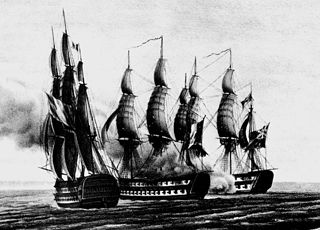
The action of 24 June 1801 was a minor naval engagement during the French Revolutionary Wars. A British ship of the line, HMS Swiftsure under Captain Benjamin Hallowell was passing westwards through the Southern Mediterranean near Cape Derna when it encountered a much larger French squadron under Contre-Amiral Honoré Ganteaume that was also returning westwards after a failed attempt to reinforce the besieged French garrison in Egypt. Although Hallowell immediately recognised the danger his vessel was in and turned to flee, the French ships were much faster and soon closed with his ship. At 14:00, three French vessels were within long gunshot and Hallowell decided that his only hope of escape lay in disabling the three ships before the rest of the French squadron could join the engagement. Turning towards the enemy, Hallowell found that his sluggish ship was unable to respond rapidly to French manoeuvres and within two hours Swiftsure was surrounded. Threatened with complete destruction and unable to escape, the British captain surrendered.

HMS Entreprenante, was a 10-gun cutter that the Royal Navy captured from the French in 1798. The British commissioned her in 1799 and she served during the French Revolutionary and Napoleonic Wars, participating in the Battle of Trafalgar. She has been the only ship of the Royal Navy to bear the name. She took part in several small engagements, capturing Spanish and French ships before she was sold in 1812 for breaking up.
